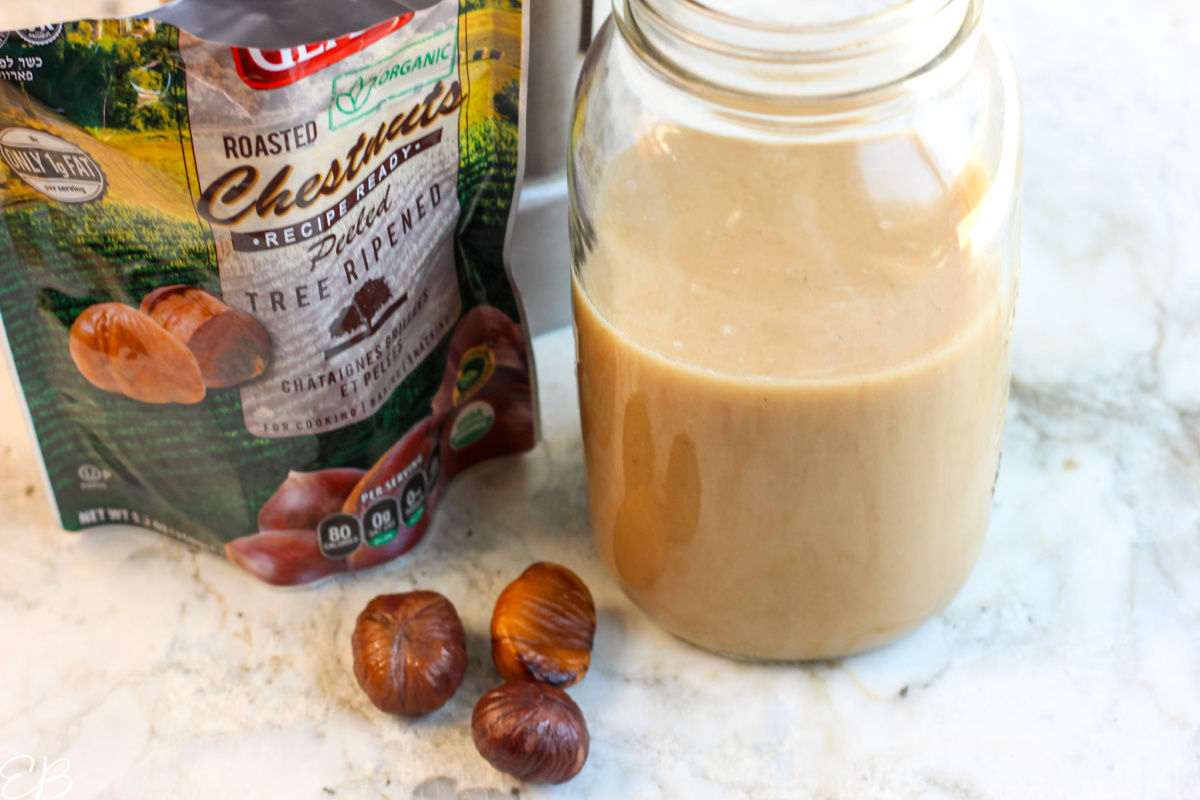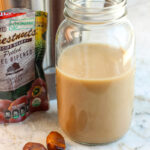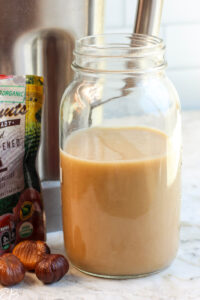I may receive a commission if you purchase through links in this post. I am not a doctor; please consult your practitioner before changing your supplement or healthcare regimen.
This Homemade Chestnut Milk recipe is the fastest one you’ll find, plus it’s so delicious and creamy! Easier to make than other non-dairy nut or grain milks, because chestnuts are naturally soft and creamy, Homemade Chestnut Milk takes just 5 minutes from start to finish — no soaking, roasting or straining!
This recipe is Vegan, Paleo, VAD and Gluten-free, plus great for Low Oxalate diets and anyone who needs a great dairy-free milk without all the additives that store bought plant-based milks have.

What are chestnuts
Whereas almonds are a drupe or seed, and peanuts are a legume, chestnuts are considered a true nut, like a hazelnut.
Chestnuts are an ancient food that have been cultivated and eaten since at least 2000 BC.
China produces more chestnuts than any other country in the world, with Spain coming in second, and Bolivia third.
Ingredients in Chestnut Milk
Just 3 ingredients (or 2, if you don’t count the water), make this creamy milk:
- water
- chestnuts — Choose organic peeled and cooked chestnuts. Thankfully, chestnuts can now easily be purchased, year round, already prepared. I have purchased this product dozens of times now, and it’s always good (and so affordable compared to organic nuts).
- sea salt, or Potassium Salt (for more minerals)
How to make Homemade Chestnut Milk
Unlike most nut, seed or grain milks, Homemade Chestnut Milk requires no straining. You simply blend the 3 ingredients, and the recipe is done!
And because chestnuts are very soft, you definitely don’t even need a special blender or machine to make this milk.
That, combined with the fact that cooked and peeled chestnuts are now easy to source year round, means Homemade Chestnut Milk, should be a lot more popular than it is. Perhaps that will come with time.
So, you simply:
- Place water, chestnuts and sea salt in blender.
- Purée about 30 seconds on medium-high speed, until completely smooth and creamy.
- Transfer to storage jar, and refrigerate. Shake before using. Keeps about 5 to 6 days.
Flavor variation on Chestnut Milk
You may certainly add vanilla to this recipe, too, if you like, or cinnamon. I give the amounts in the Notes section below the main recipe.
But my favorite flavor variation is actually Carob Chestnut Milk: Add roasted carob powder and a very small amount of pure maple syrup (or preferred sweetener) to blender. This treat is delicious to drink by the gulp when you’re hot and thirsty or need a healthy energizing sweet drink. Full recipe in the Notes section below the main recipe.

Benefits of making and drinking Homemade Chestnut Milk
- Making any plant-based milk, instead of buying, reduces the demand for plastics and packaging (meaning we’re better stewards of the planet). It also means we’re exposed to less plastics, as most packaging sloughs off into our food, and we ingest it, adding microplastics to our bodies.
- Organic chestnuts are grown sustainably, unlike most almonds.
- Chestnut Milk can be less expensive than homemade organic nut milks, and homemade milk is less expensive than store bought.
- Making milk homemade means no extra additives, like sugar, vegetable oils, harmful vitamins or inflammatory thickeners.
- Lastly, chestnuts themselves are a gentle, nourishing food:
- Chestnuts are lower in oxalates than most nuts, seeds or grains. (Oxalate data is very confusing online, so sources vary on this, but in fact, 3 whole chestnuts are considered Low Oxalate, and 6 to 8 chestnuts are medium oxalate. Therefore, depending on the serving size, Homemade Chestnut Milk is Low to Medium Oxalate.)
- They are high in Potassium, Vitamin C, Vitamin B6, Folate and Thiamine.
- Chestnuts are lower in calories than other nuts, despite being naturally sweet.
- They offer a moderate amount of fiber.
Most foods should be eaten in moderation, and chestnuts are no exception. The only cautions with chestnuts are: One, like most nuts and seeds, they contain polyunsaturated fatty acids, which aren’t the best fats for our body, and need to be eaten in the right ratio with omega-3 fatty acids. But chestnuts do have a nice monounsaturated fat profile.
Secondly, like most plant-based foods, chestnuts contain more copper than zinc. I personally supplement with zinc and eat all copper rich foods in a balanced way.
(For those on a low vitamin A diet, chestnuts have no vitamin A, but they are high in manganese.)

Homemade Chestnut Milk (5 minutes, Vegan, Paleo)
Equipment
- measuring cup
Ingredients
- 2 cups water
- 1 slightly heaping cup (or 5.2 ounces) chestnuts peeled and cooked (I use and recommend this brand of organic chestnuts, which provides 5.2 ounces of ready to use/eat chestnuts. Use the entire bag for this recipe.)
- ¼ teaspoon sea salt or Potassium Salt (for more minerals)
Instructions
- Place water, chestnuts and sea salt in blender.
- Purée about 30 to 50 seconds on medium-high speed, until completely smooth and creamy. (I like to start on the lowest speed, and then increase to the highest speed.)
- Transfer to storage jar, and refrigerate. Shake before using. Keeps about 5 to 6 days.

Notes
Flavor variations
- Add up to 2 teaspoons real vanilla extract, and/or 1 teaspoon Ceylon cinnamon to the blender before blending.
- Add roasted carob and pure maple syrup:
- Carob Chestnut Milk recipe: Add 2 Tablespoons roasted carob powder and 1 Tablespoon + 1 teaspoon pure maple syrup (or preferred sweetener) to blender before blending.
Nutrition
You can Pin this recipe here:





Peter says
The bag of chestnuts you recommend (and suggest using the entire bag) cost a whopping $36.99 ! on Amazon. I would NEVER spend that much on a small batch of milk! And I predict that no one else would either!!
Megan says
Hi Peter, I can see your confusion if that were the case, but the price is for 12 bags! 😉